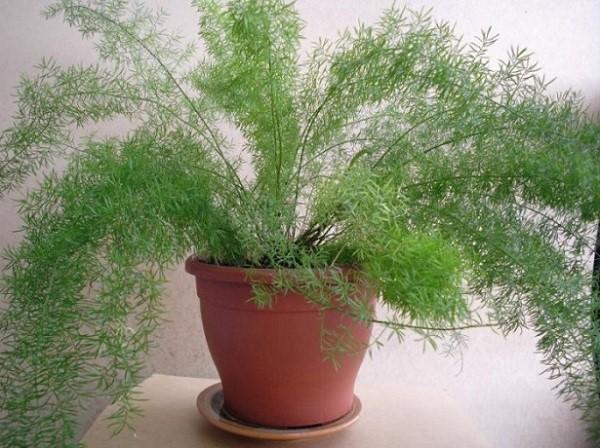What indoor asparagus loves and how to care for a plant
 Asparagus is an original flower, it compares favorably with the usual indoor plants, since it has an unusual leaf shape. Instead of a large leaf plate, the shoots of the plant are densely covered with thin needles, which makes it look like a lush Christmas tree.
Asparagus is an original flower, it compares favorably with the usual indoor plants, since it has an unusual leaf shape. Instead of a large leaf plate, the shoots of the plant are densely covered with thin needles, which makes it look like a lush Christmas tree.
It's not very difficult to grow such an amazing flower if you know some of its features. The main thing to pay attention to is:
- lighting;
- indoor air temperature;
- watering;
- top dressing;
- transfer.
Where is the best place to put asparagus?
Almost all varieties asparagus they love diffused light, so it is better to choose a northeastern window sill as a flower residence. The plant will have enough light on it, moreover, direct sunlight will not be able to harm it.
The sunny side can be set aside for Sprenger's asparagus - he just loves to have a lot of light.
As for the winter period, when there is less natural light, the flower is either supplemented with illumination, or it is rearranged to a more illuminated place until spring.
Do not put asparagus near the radiator - dry air emanates from it, from which the needles will begin to crumble.
The fluffy herringbone is very sensitive to the low temperature in the room. Comfortable degrees for her are from 22 to 25, and only during the rest period, the permissible (and necessary) decrease is from 15 to 18 degrees Celsius. At lower values, the flower drops all leaves.
How to water?
In winter, asparagus does not need frequent watering, it is enough to keep the soil moist, preventing it from drying out completely. But with the arrival of spring, more frequent soil moistening will be needed - up to 3 times a week.
Asparagus is very fond of high humidity, so you should regularly spray the twigs and periodically carry out water procedures for it.
How often to feed?
All asparagus species have inherent active growth. In this regard, during the growing season, the flower needs periodic fertilizing with complex mineral fertilizers, but not more than three times a month. A single (during the season) feeding with a small amount of organic matter (bird droppings) is also allowed.
There is no need to fertilize the plant in winter.
Transplant features
The root system of asparagus is capable of completely filling a small pot in a year. Young bushes must be replanted annually in the spring, each time picking up a pot several centimeters larger in diameter than the previous one, otherwise the roots will simply tear it apart. It is enough to replant adult plants once every 3 years.
When transplanting a large bush, old overgrown roots can be partially removed, and the tips of the rest can be trimmed.
As for pruning, asparagus absolutely does not need it - the flower itself is capable of forming beautiful, long and fluffy branches. It is enough just to cut dry shoots in time and install (if desired) support.